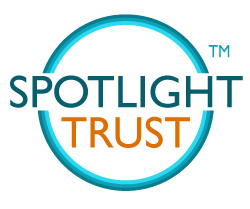The 5 Facets of Trust
A practical model for trust and the foundation of
Trust-Centered™ Leadership
Defining Trust
At Spotlight Trust, we define trust as a placement of confidence that stems from a combination of a willingness to be vulnerable and to actively engage with the unknown.
Trust involves taking a risk and dancing with uncertainty, with the belief that you’ll be better for it, though a positive outcome isn’t guaranteed. That’s why it’s “trust” and not “a sure thing.”
The 5 Facets of Trust
Originally conceived by Lisa Lambert and developed alongside Rick Kitagawa at Spotlight Trust, the 5 Facets of Trust is a practical model to understand and assess trust in different contexts. Leaders and organizations can leverage the 5 Facets of Trust to effectively earn, extend, strengthen, and even restore trust. Each Facet encompasses a collection of Trust-Centered skills and competencies we can choose to learn, practice, and improve.
When it comes to trust, context matters. How trusted you are depends on the context. For example, Lisa would trust her mom to help her in caring for a medical emergency, but wouldn’t trust her to navigate on a hike.
Typically, how trusted we are comes down to our least trustworthy Facet – trust is a weakest-link paradigm.
The quality of being clear and easy to understand.
Credibility is the capacity or condition for belief. We break this down further into 10 categories of what we call credibility signals, which, for the most part, you have agency over to develop.
Consistency is the harmony of conduct, practice, parts, and/or features.
Caring is the feeling and demonstration of kindness, concern, or compassion for others.
Connection is the act of relating to and building relationships with others.
The 3 Dimensions of Trust
The best way to build trust is in 3D. The 5 Facets of Trust are applied across 3 Dimensions of Trust that each needs to be enriched to harness the full potential of trust. This is a scaffolded model, with each Dimension building on the previous level.
1. Trust in yourself
This is the foundation of all trust. Our self-trust influences how we show up in the world and place our trust in the people and things around us.
2. Trust in another
This is how we relate to and build connections with one another. The core of human interaction is one-on-one relationships.
3. Trust at scale
As things scale, they often become more complex. So does trust, and building trust at scale involves a combination of relationship dynamics, leadership, processes, and systems.

